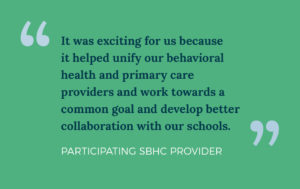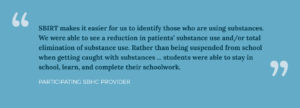
Adolescent Substance Use Prevention in School-Based Health Centers
We have a responsibility to do everything we can to make sure young people grow up to have healthy, strong futures.
One thing that stands in the way of that is drug and alcohol use. Drinking and substance misuse can negatively affect young people’s school performance, future job prospects, and physical and mental health, damaging their lives well into adulthood.
In addition, we know that substance use rarely occurs in a vacuum: other co-occurring factors in young people’s environments can affect their wellbeing and contribute to or exacerbate substance use. Therefore, in our work on substance use prevention, we recognize the need for school-based health centers (SBHCs) to address proactively other social influencers of health, such as poverty, racism, homelessness, system involvement, trauma, and community health and safety.
SBHCs provide access to healthcare for our nation’s most vulnerable youth. We believe that connections to schools, healthcare providers, and community resources can be key elements in addressing these social influencers and ultimately preventing adolescent substance use.
This toolkit contains a wide variety of resources designed to support school-based health professionals in implementing SBIRT (Screening, Brief Intervention, and Referral to Treatment) and creating culture shifts related to preventing adolescent substance use.
What Is SBIRT?
SBIRT (Screening, Brief Intervention, Referral to Treatment) is an innovative, evidence-based approach to addressing drug and alcohol use with adolescents.

Its core components include :
- Regular, de-stigmatized, and universal screening for substance use using validated tools;
- Consideration of substance use as a continuum rather than a dichotomous “addicted versus not addicted” judgment;
- Use of motivational interviewing-based, patient-centered talk versus directive, prescriptive talk;
- Broad understanding of “referral to treatment,” to include traditional treatment as well as support and anticipatory guidance for all levels of use or abstinence, including harm reduction methods when appropriate;
- Facilitation of smooth, bidirectional transitions among primary care, behavioral health, and specialty addiction treatment when indicated.
Screening refers to the routine, universal administration of validated questions to identify potential risks related to alcohol and drug use, followed by positive reinforcement and anticipatory guidance for youth who screen as “no” or “low” risk.
Brief intervention describes one or more short, motivational conversations, typically incorporating feedback, advice, and goal setting around decreasing “moderate” risk related to substance use. This step is intended to prevent progression to more serious levels of use.
Referral to treatment describes the process of connecting individuals with more high-risk substance use to appropriate assessment, treatment, and/or additional services based on their level of need. SBIRT has emerged as a critical strategy for targeting the large but often overlooked population of adolescents who have initiated substance use but have not yet experienced adverse consequences that are attributed to high-risk use.
From Abt Brief: The Impact of the COVID-19 Pandemic on School SBIRT Programs: Issues and Solutions
SBIRT is widely recommended by health organizations, including the American Medical Association2, the American Academy of Pediatrics3, Bright Futures4, 5, the U.S. Surgeon General6, the World Health Organization7, 8, NIAAA8, and the National Institute on Drug Abuse (NIDA)9. Nonetheless, it remains underimplemented.10, 11, 12, 13 Common perceived barriers include limited time during the patient visit, lack of knowledge and training, fearing negative patient reactions, and feeling uncomfortable discussing substance use. This toolkit includes information and tools designed to counter these barriers.
To see a video demonstration of the SBIRT process in a school-based health center, see the video below.
Why SBIRT in SBHCs?
Adolescent substance use is common. More than half of high school seniors in the United States have used alcohol in the last year; more than a third have used marijuana, and 15% of high school students report having ever used select illicit or injection drugs14, 15. When school-based health centers implement SBIRT, they are addressing a behavior common among teenage students, as adolescents use substances for a variety of reasons. The adolescent brain is oriented to favor new experiences and engage in risky behaviors, meaning drug use may coincide with these normal developmental urges. In addition, adolescents may use substances as they seek to find out who they are as individuals, try to deal with problems, do better in school, or react to social pressure from friends.16
used select illicit or injection drugs14, 15. When school-based health centers implement SBIRT, they are addressing a behavior common among teenage students, as adolescents use substances for a variety of reasons. The adolescent brain is oriented to favor new experiences and engage in risky behaviors, meaning drug use may coincide with these normal developmental urges. In addition, adolescents may use substances as they seek to find out who they are as individuals, try to deal with problems, do better in school, or react to social pressure from friends.16
Adolescent substance use can result in negative consequences. A number of negative safety and legal consequences are more likely to occur when adolescents use substances like alcohol and marijuana17, 18. Moreover, substance use can impact adolescents’ brain development, affecting memory, attention, and information processing.19 Like primary care and pediatric health settings, school-based health centers play an important role in conveying clear and consistent messaging about the potential outcomes of using substances during adolescence.

Adolescence is a critical time to prevent later addiction. When health professionals implement the SBIRT model with adolescent patients, they are acting to 1) help delay initiation of use with teens who have not tried substances; 2) increase the motivation of teens who do use to cut back or abstain; and, 3) help teens experiencing a substance use disorder get help through specialized treatment. Because the large majority of Americans experiencing a substance use disorder started using before the age of 1820, health professionals can play an important role in preventing addiction later in life.
Screening tools work. Screening instruments such as the CRAFFT, the S2BI, and others* are validated specifically with adolescents, take little time to complete, and are feasible for routine use in health care settings. These screening tools can be administered verbally by a health professional or self-administered by an adolescent patient, either on paper or in electronic format. By scoring answers to just a few questions, health professionals can quickly learn how often an adolescent uses substances, which substances are used, and what consequences the adolescent is experiencing associated with use. These tools also indicate to the health professional what response is most appropriate.
*SBHA recommends using the most recent version of any validated tool.
Brief interventions are well suited for adolescents. Short conversations that employ principles of motivational interviewing can increase the likelihood that an adolescent will cut back or abstain from substance use21. Motivational interviewing is a technique well suited for adolescents because of their desire for autonomy and resistance to authority22. Health care professional can learn how to perform effective brief interventions by participating in a short training session.
Most teens who would benefit from treatment do not receive it. There is a large gap between the number of adolescents who could benefit from specialized treatment and the percentage of those who actually obtain it23. By identifying these students and proactively connecting them to further assessment, health professionals increase access to critical services. Several types of treatment are available specifically for adolescents, and studies show they can produce outcomes such as decreased use, decreased criminal-legal system involvement, and improved psychological adjustment and school performance.
There’s room for improvement. Many health care professionals do not routinely address substance use with adolescent patients. In one study, 82% of 10th graders reported seeing a doctor in the past year, but only half of them were asked about drinking alcohol24. Of those who were frequent drinkers, only 25% were asked. Meanwhile, only 27% of marijuana users were advised to reduce or quit by a doctor. Failing to ask about substance use is a missed opportunity to provide important care. By implementing a standardized SBIRT workflow, SBHCs can help ensure all patients are responded to with the appropriate positive reinforcement, anticipatory guidance/brief advice, brief intervention, or referral to treatment.
SBHCs are uniquely positioned to support adolescent substance use prevention. Students are 21 times more likely to visit an SBHC for behavioral health care than they are to visit a community clinic25. Students with access to behavioral health services at SBHCs report lower frequencies of cigarette, marijuana, and unauthorized prescription drug use26. SBHC providers who have relationships with teens may be better situated to identify and respond to substance use in their adolescent patients.
The video below describes the rationale for and potential benefits of SBIRT in SBHCs.
Resources:
- Improving Adolescent Health: Facilitating Change for Excellence in SBIRT
- The Evidence for School-Based SBIRT
- AAP Policy Statement: Substance Use Screening, Brief Intervention, and Referral to Treatment
- AAP Clinical Report: Substance Use Screening, Brief Intervention, and Referral to Treatment
- School-Based Health Clinics: Critical Access Points For Confronting The Addiction Epidemic
- Alcohol Use Screening and Behavioral Counseling with Adolescents in Primary Care: A Call to Action
- Who’s Doing What? The Epidemiology of Adolescent Substance Use
- The Impact of Substance Use on the Developing Adolescent Brain
- Evaluation of Youth Substance Use Prevention – Abt Associates
References:
- Abt Associates. The Impact of the COVID-19 Pandemic on School SBIRT Programs: Issues and Solutions. https://www.abtassociates.com/insights/publications/report/the-impact-of-the-covid-19-pandemic-on-school-based-substance-use. Published 2021.
- Levy SJ, Williams JF, AAP Committee on Substance Use and Prevention. Substance Use Screening, Brief Intervention,and Referral to Treatment. Pediatrics 2016;138(1).
- Committee on Substance Abuse. Substance Use Screening, Brief Intervention, and Referral to Treatment for Pediatricians. American Academy of Pediatrics. 2011;128(5):e1330-e1340.
- American Academy of Pediatrics Committee on Substance Abuse. Policy Statement -Alcohol Use by Youth and Adolescents: A Pediatric Concern. Pediatrics. 2010;125(5):1078-1087.
- S. DHHS. The Surgeon General’s call to action to prevent and reduce underage drinking. In: Office of the Surgeon General, ed. Washington, DC: US Department of
- Health and Human Services; 2007.
- Babor TF, McRee BG, Kassebaum PA, Grimaldi PL, Ahmed K, Bray J. Screening, Brief Intervention, and Referral to Treatment (SBIRT) toward a public health approach to the management of substance abuse. Substance abuse. 2007;28(3):7-30.
- National Institute on Alcohol Abuse and Alcoholism. Alcohol Screening and Brief Intervention for Youth: A Practitioner’s Guide. Bethesda, MD: US Dept of Health and Human Services; 2011.
- National Institute on Drug Abuse. Principles of Adolescent Substance Use Disorder Treatment: A Research-based Guide. NIDA;2014. NIH Publication Number 14-7953.
- National Institute on Alcohol Abuse and Alcoholism. Alcohol Screening and Brief Intervention for Youth: A Practitioner’s Guide. Bethesda, MD: US Dept of Health and Human Services; 2011.
- Harris BR, Shaw BA, Sherman BR, Lawson HA. Screening, brief intervention, and referral to treatment for adolescents: Attitudes, perceptions, and practice of New York school-based health center providers. Subst Abus. 2016;37(1):161-167.
- Harris SK, Herr-Zaya K, Weinstein Z, et al. Results of a statewide survey of adolescent substance use screening rates and practices in primary care. Subst Abus. 2012;33(4):321-326.
- Lunstead J, Weitzman ER, Kaye D, Levy S. Screening and brief intervention in high schools: School nurses’ practices and attitudes in Massachusetts. Subst Abus. 2017;38(3):257-260.
- Monitoring the Future: 2020 Survey Results. National Institute on Drug Abuse; National Institutes of Health; U.S. Department of Health and Human Services. https://www.drugabuse.gov/drug-topics/related-topics/trends-statistics/infographics/monitoring-future-2020-survey-results Updated December 17, 2020. Accessed December 2, 2021.
- CDC. Youth Risk Behavior Surveillance—United States, 2019. MMWR Suppl 2020;69(1):1-83.
- NIDA. Why do adolescents take drugs?. National Institute on Drug Abuse website. https://www.drugabuse.gov/publications/principles-adolescent-substance-use-disorder-treatment-research-based-guide/frequently-asked-questions/why-do-adolescents-take-drugs. Updated May 24, 2020. Accessed July 12, 2021.
- NIDA. Alcohol. National Institute on Drug Abuse website. https://teens.drugabuse.gov/drug-facts/alcohol. Updated June 25, 2021. Accessed July 12, 2021.
- NIDA. Marijuana. National Institute on Drug Abuse website. https://teens.drugabuse.gov/drug-facts/marijuana. Updated June 25, 2021. Accessed July 12, 2021.
- Squeglia LM, Jacobus J, Tapert SF. The influence of substance use on adolescent brain development. Clinical EEG and neuroscience. 2009;40(1):31-38.
- The TEDS Report: Age of Substance Use Initiation among Treatment Admissions Aged 19 to 30. Substance Abuse and Mental Health Services Administration. http://www.samhsa.gov/data/sites/default/files/WebFiles_TEDS_SR142_AgeatInit_07-10-14/TEDS-SR142-AgeatInit-2014.htm. Published July 14, 2014. Accessed December 2, 2021.
- Levy S, Williams J; Committee on Substance Use and Prevention. Substance Use Screening, Brief Intervention, and Referral to Treatment. Pediatrics. 2016; 138(1): 2016-1210. DOI: 10.1542/peds.2016-1210.
- Silvers JA, Squeglia LM, Rømer Thomsen K, et al. Hunting for what works: Adolescents in addiction treatment. Alcoholism: Clinical and Experimental Research. 2019; 43(4): 578-592.
- Results from the 2012 National Survey on Drug Use and Health: Summary of National Findings. Substance Abuse and Mental Health Services Administration. https://www.samhsa.gov/data/sites/default/files/NSDUHresults2012/NSDUHresults2012.pdf. Published September, 2013. Accessed December 2, 2021.
- Hingson RW, Wenxing Z, Iannotti RJ, Simons-Morton B. Physician Advice to Adolescents About Drinking and Other Health Behaviors. Pediatrics. 2013;131: 249.
- Juszcack L, Melinkovich P, Kaplan D. Use of health and mental health services by adolescents across multiple delivery sites. Journal of Adolescent Health. 2003; 32(6 Suppl): 108-118.
- Paschall MJ, Bersamin, M. School-based mental health services, suicide risk, and substance use among at-risk adolescents in Oregon. Preventive Medicine. 2018; 106: 209-215.
- Hanes M. Effects and Consequences of Underage Drinking. Juvenile Justice Bulletin. 2012.
Best Practices for SBIRT in SBHCs
The uniquely integrated and collaborative SBHC model allows for an expanded version of Screening, Brief Intervention and Referral to Treatment (SBIRT) that is capable of helping youth in addition to substance use prevention.
While we believe that each best practice is important on its own, we recognize that many components are also aspirational and take time, so we encourage sites to approach full implementation as a long-term change process.
We also expect that any SBHCs pursuing SBIRT implementation are already proficient in the School-Based Health Alliance’s Core Competencies for SBHCs.
Screening
Screening
Learn MoreBrief Intervention
Brief Intervention
Learn MoreReferral to Treatment
Referral to Treatment
Learn MoreIntegrated Treatment Options
Integrated Treatment Options
Learn MoreSBIRT as an Alternative to Discipline
SBIRT as an Alternative to Discipline
Learn MoreBilling & Reimbursement
Billing & Reimbursement
Learn MoreDemonstrating Value and Positive Impacts
Demonstrating Value and Positive Impacts
Learn MoreWorkforce Training and Support
Workforce Training and Support
Learn MoreAbout the SBIRT-in-SBHCs Initiative
From 2015 until 2021, the School-Based Health Alliance, with generous support from the Conrad N. Hilton Foundation, led an effort to test the adaptation of SBIRT for youth substance use prevention into school health care settings. The process of training school-based health providers in SBIRT and testing the feasibility of the approach across a variety of sites around the country afforded us the opportunity to confront implementation challenges, share our expertise, and identify keys to success. Through our own projects, as a partner on numerous other projects, and as founders and leaders of the National School-Based SBIRT Learning Community, we continue to promote and refine the SBIRT in-school model.

Our work focused on three areas:
- Increased training for the SBHC field, using new models and leveraging technology to serve more providers and centers via national learning collaboratives, while also creating legacy training tools. This work included 44 school-based health centers across 17 states.
- Development of the National School-Based SBIRT Learning Community to connect a diverse group of researchers, providers, administrators, and others to foster collaboration and sharing of tools and resources, increase partnerships and publication, and collectively agree on best practices to share with the field.
- Creation of a comprehensive web-based toolkit, drawing from lessons learned through SBHA’s implementation experiences as well as those of the National School-Based SBIRT Learning Community. This toolkit is a legacy for the field and a resource for SBHCs who would like to implement SBIRT on their own.
Resources:
Looking Ahead

SBHCs and other school-based health providers have a unique opportunity to meet young people where they are and offer expert support and clinical treatment for the wide range of issues that may affect them as adolescents, as well as establish patterns for a health adulthood. Research shows that early intervention, education, and prevention, as well as strong relationships with trusted adults, are often key to young people’s future success, and a lifelong deterrent to substance use.
School-Based Health Alliance has invested many years in refining our model for school-based SBIRT. While we have a wealth of knowledge and resources to share on the topic of substance use prevention, we are especially proud of our work to position adolescent substance use in the context of the whole adolescent. Through this toolkit, our resources, technical assistance and consulting work, we provide data-driven support for the many co-occurring issues that can affect young people, and often lead to substance use.
We encourage any SBHCs or school-based providers interested in addressing youth substance use prevention to integrate their efforts with other measures and interventions designed to meet adolescents where they are—in developmentally appropriate and respectful ways, within the context of their unique needs and experiences—and in collaboration with other school and community partners.
Acknowledgments
We are especially grateful for the expertise of our steering committee, training and Project ECHO faculty, guest speakers, and National School-Based SBIRT speaker series panelists.
Steering committee:
- Rebecca Gostlin, MEd, LPC
- Sierra Lau, MPH
- Tracy McPherson, PhD
- Amy Ranger, MPH
- Brie Reimann, MPA
- Naomi Schapiro, CPNP, PhD
- Rachel Sebastian, MA
- Samira Soleimanpour, PhD, MPH
- Angelia Williams, MSN, RN
- Ken Winters, PhD
- Francie Wolgin, MSN
- Samantha Yeun
Training and Project ECHO faculty:
- Christina Drymon, PhD
- Sara Geierstanger, MPH
- Anna Goddard, PhD, APRN, CPNP-PC
- Allison Kilcoyne, MS, RN, FNP-BC
- Naomi Schapiro, CPNP, PhD
- Samira Soleimanpour, PhD, MPH
We would also like to acknowledge the important contributions made by the school-based health center teams who participated in our learning collaboratives:
SBIRT-in-SBHCs participants
- 2014 – 2016 participants
- Beaverton High SBHC (OR)
- Merlo High School SBHC (OR)
- Skyline High School/Life Academy (CA)
- United for Success Middle School (CA)
- Madison Middle School Health Center (CA)
- Coolidge High SBHC (DC)
- Dunbar High (DC)
- Francis Academy SBHC (MD)
- Auburn Gresham (IL)
- 2017 – 2018 participants
- Child and Family Agency of SE Connecticut(CT)
- New London High School SBHC
- Fitch High School SBHC
- Pawcatuck Middle School SBHC
- Great Lakes Bay Health Centers(MI)
- Arthur Hill High School SBHC
- Saginaw High School SBHC
- Thunder Bay Community Health Service(MI)
- Onaway Area Community School SBHC
- Cheboygan Intermediate School SBHC
- Waianae Coast Comprehensive Health Center(HI)
- Waianae High School SBHC
- Waianae Intermediate School SBHC
- Child and Family Agency of SE Connecticut(CT)
- 2019 – 2020 participants
- Child & Family Agency of Southeastern Connecticut(CT)
- Bennie Dover Jackson Middle School SBHC
- West Side Middle School SBHC
- Erie Family Health Center (IL)
- Erie Amundsen SBHC
- Jessie Trice Community Health System(FL)
- Miami Northwestern/ John H Peavy SBHC
- Brownsville Middle School SBHC
- LifeLong Medical Care (CA)
- Elmhurst United Health Center
- West Oakland Middle School Health Center
- Memorial Hermann Community Benefit Corporation (TX)
- Terry Health Center
- NYC Health and Hospitals Gotham School-based Health(NY)
- Gotham School-based Health Corlears Educational Campus
- Gotham School-based Health Bushwick Educational Campus
- PanCare of Florida, Inc.(FL)
- PanCare of Florida at Rosenwald High School
- PanCare of Florida at Rutherford High School
- Rainelle MedicalCenter (WV)
- Greenbrier West Wellness Center
- Eastern Greenbrier Wellness Center
- Valley Health Care, Inc. (WV)
- Elkins Middle School SBHC
- Elkins High School SBHC
- Tygarts Valley Middle/ High School SBHC
- Child & Family Agency of Southeastern Connecticut(CT)
- 2020 – 2021 Participants
- Cahaba Medical Care Foundation (AL)
- Cahaba Medical Care – CJ Donald Elementary
- Cahaba Medical Care – Brent Elementary
- The Health Center (WA)
- Student Health Options dba the Health Center
- Methodist Health System Foundation (LA)
- Chalmette High School School-Based Health Center
- Chalmette High School School-Based Health Center Rowley Outreach
- University of Kansas Health System (KS)
- Campus Care Clinic at Topeka High School
- The Wright Center (PA)
- West Scranton School-Based Practice
- Northeast Scranton Intermediate School-Based Health Center
- South Scranton Intermediate School-Based Health Center
- Cahaba Medical Care Foundation (AL)
General SBIRT Resources
- To see additional resources developed by fellow Hilton grantees, visit this compendium of Substance Use Prevention Resources.
- SBIRT Oregon
- Adolescent SBIRT by NORC at the University of Chicago
- Adolescent SBIRT Implementation Checklist by the Mosaic Group
- Frameworks Institute: Substance Use and Addiction
- Getting Candid: Framing the Conversation Around Youth Substance Use Prevention
- School-Based Screening, Brief Intervention and Referral to Treatment: An Implementation Playbook by Reclaiming Futures
- SBIRT in Schools Resource Toolkit: Verbal Substance Use Screening in Massachusetts Schools
- Colorado’s SBIRT-SBHC Project Summary and White Paper
- Resources to support school-based health centers in strengthening their relationships with youth, schools, and communities to better address adolescent substance use:
- Health Centers and Schools: Uniting for Young People’s Success
- Lead the Way: Engaging Youth in Healthcare
- HIPAA/FERPA Comparison Tool
- How Schools Work, and How to Work with Schools
- Effective School and Community Partnerships to Support School Mental Health
- School Nursing & School-Based Health Centers in the United States: Working Together for Student Success